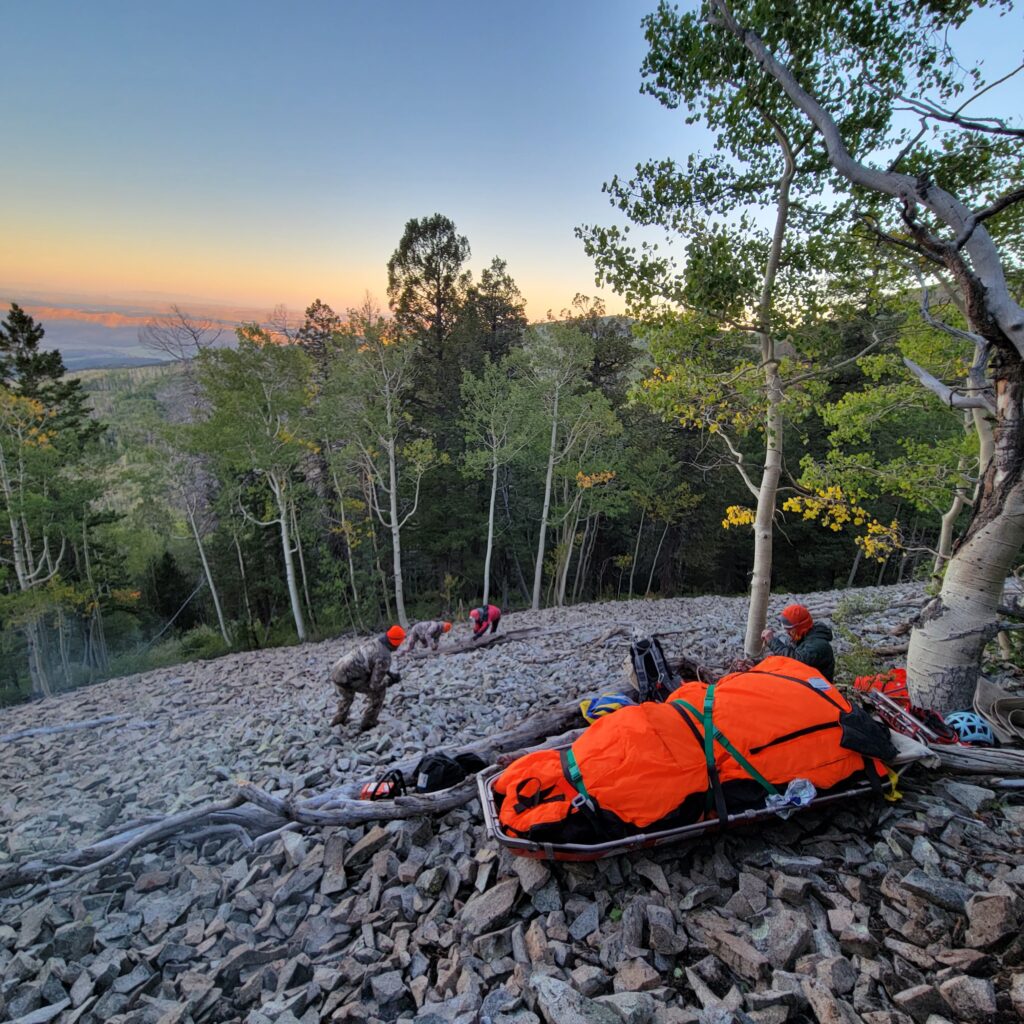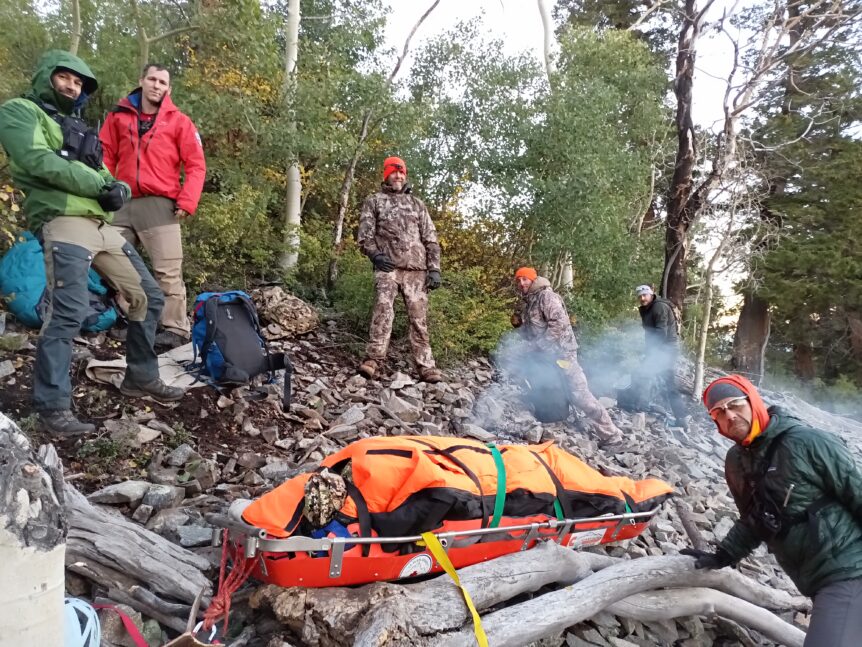By La Plata County Search and Rescue, submitted by LPCSAR member Coral Smith
On September 23, 2022, LPCSAR responded to an evening call. At 19:47, hunter #1 in a party of four used his InReach to report hunter #2 had a broken ankle in the remote La Plata Mountains. Hunter #2 had fallen down a steep slope, sustained an ankle injury, was unable to put weight on it, and found himself in very steep terrain with thick undergrowth. His situation was not currently life threatening but the group was unable to make a fire, and at 10,100 feet elevation, the temperature was dropping quickly.
At 21:05, LPCSAR members arrived at the rally point; getting there by vehicle was an off-road adventure in its own right, but a tale for another day. A medical/hasty team member went in first with only the bare essentials to move light and fast to the patient and evaluate the situation. While the team waited at the rally point, a medical member met up with two members of the hunting party just after midnight. He relayed to the LPCSAR team that this was most likely going to be a technical rope rescue, and that chainsaw work would be necessary to remove a log. Serendipitously, a few Technical Rope Rescue Team (TRRT) members were onsite and the long night continued.
A two-man team departed with the chainsaw to clear the trail and make patient contact. The rest of the team traveled with the litter, wheel, technical rope gear and other items for the patient’s comfort. An LPCSAR moto-team member also attempted a quick access on his dirt bike but was eventually thwarted by the conditions. He rallied with the rest of the team for the final, steepest section of the mountain, where the scree began.
The terrain was unforgiving, with lots of brush and grass on shoebox-sized rocks with smaller rocks mixed in, and while the log was cleared, the trail previous members had tread was nowhere to be found. The team left the trail at 9,400 feet and the patient was at approximately 10,100 feet; this made for an energy-demanding ascent of the steep and perilous mountain.
Contact between the hunting crew, medical/hasty team and team 2 was made around 03:00. The team secured hunter #2’s injured leg, wrapped him in winter patient packaging to prevent hypothermia, and placed him comfortably in the litter. Given the scree field, this might be one of the few times sleeping in the litter would be considered comfortable and the patient did indeed sleep while a plan for the next day was considered.

At 04.00, team members checked on their own and each other’s mental and emotional fitness, a standard procedure for LPCSAR and then they discussed extraction options for the TRRT resources on the scene. They could execute multiple, sectional lowering techniques until finally reaching flatter terrain where the team could possibly wheel hunter #2 out, but this would have dramatically increased rescuer exposure to excessive risk given the scree, slope and overgrowth, while also possibly jeopardizing the patient in the litter.
There was one more option: HAATS (Colorado Army National Guard High-Altitude ARNG Aviation Training Site), which has Blackhawks capable of hoist maneuvers to assist the team in the morning. Hallelujah! Now the team just had to get hunter #2 to a flatter area with fewer trees for the hoist maneuver.
The team surrounded the patient while some members heated rocks and passed them to each person; it was going to be a long, cold few hours till dawn. It was impossible to rest with stones stabbing the team member’s backs and ribs, but sharing stories and jokes kept spirits high. The night was clear and the stars were bright.

At daybreak, the team stirred and reviewed the plan to move hunter #2. To prepare for the extraction, the team performed a technical lower down the steep angle into the middle of the scree field. This would give about 70 feet above and below the patient with 100 lateral feet for the hoist operation. Some members created a ledge in the middle of the scree field so the patient had a more level spot.
Link to Blackhawk Extraction Video
At 09:15, the Blackhawk helicopter approached the landing zone. Two members of Vail Mountain Rescue Group (VMRG) were lowered and the Blackhawk went into a holding pattern away from the team’s location to minimize rotor wash. Everyone reworked the packaging to help rig hunter #2 into the hoisting system. The Blackhawk did two passes; the first took the patient and one VMRG member and the second retrieved the remaining VMRG member. Hunter #2 had a thrilling ride to Durango airport and was transported by Durango Fire Department to Mercy Hospital.
While hunter #2 was safe and sound, an LPCSAR member was monitoring another situation. Upon arriving on the scene, hunter #2 was the focus. The LPCSAR member was lighting the area to get him in the litter and had a bird’s eye view of the situation. Once the lighting was no longer needed, the LPCSAR member walked over to hunter #3, who was sitting on a log, white-knuckled, gripping a small nearby tree. Upon questioning, he shared he was deathly afraid of heights; he knew he needed to stay warm but was too paralyzed to move. Our team member retrieved his pack, added clothing layers and got him to a more level area to wait out the night.
In the morning, our member gave hunter #3 the camera to take pictures (which is why we have them, thank you hunter #3!) The thinking was if his focus could be redirected, it might relieve some of his anxiety.
After hunter #2 was airlifted out, hunter #3 was able to climb down the rocks, but it took a concerted effort. Hunter #3 had not eaten nor had much water in over 18 hours, and we were close to having a second patient. Fortunately, hunter #3 made it safely down the mountain. When the team and hunter #3 reached the vehicles, the team member made sure to watch him drink and eat immediately; it was clear that the friends would take over.
What does hunter #3 have to do with hunter #2’s extraction? Many times, the reported injury may not be the only person that needs assistance on the scene. We had two parties to safely extract that day.
When the team arrived at the trailhead with all the gear, they were met by exuberant friends of the patient and fellow LPCSAR member bearing a hot delicious breakfast of burritos, doughnuts and coffee, for which the hungry and depleted members were grateful. As of 12.30, all personnel were out of the field.
We checked in with the patient, hunter #1. The takeaways were that the team was professional, kind and caring and made the experience almost fun – minus the injury. Amazingly, hunter #1 conveyed that it was an experience he will always cherish.
While this may not be the most exciting search and rescue story, lacking blood, gore, and major injuries, it resonates because the team spirit was felt by all. Just over ten members recounted their experiences and the most common phrases included collaboration, unity, harmony, good company, cheerful, helpful, and endurance. It was also noted that in a post-Leo Lloyd world, we all need to step up our game in all aspects of SAR and stay committed to growing together for continuous improvement. As LPCSAR members, we are in it for the long haul.
Editor’s note: Leo Lloyd was a beloved and well-known member of LPCSAR who unexpectedly and tragically died in 2022.

